The Intel 9th Gen Review: Core i9-9900K, Core i7-9700K and Core i5-9600K Tested
by Ian Cutress on October 19, 2018 9:00 AM EST- Posted in
- CPUs
- Intel
- Coffee Lake
- 14++
- Core 9th Gen
- Core-S
- i9-9900K
- i7-9700K
- i5-9600K
Gaming: Shadow of the Tomb Raider (DX12)
The latest instalment of the Tomb Raider franchise does less rising and lurks more in the shadows with Shadow of the Tomb Raider. As expected this action-adventure follows Lara Croft which is the main protagonist of the franchise as she muscles through the Mesoamerican and South American regions looking to stop a Mayan apocalyptic she herself unleashed. Shadow of the Tomb Raider is the direct sequel to the previous Rise of the Tomb Raider and was developed by Eidos Montreal and Crystal Dynamics and was published by Square Enix which hit shelves across multiple platforms in September 2018. This title effectively closes the Lara Croft Origins story and has received critical acclaims upon its release.
The integrated Shadow of the Tomb Raider benchmark is similar to that of the previous game Rise of the Tomb Raider, which we have used in our previous benchmarking suite. The newer Shadow of the Tomb Raider uses DirectX 11 and 12, with this particular title being touted as having one of the best implementations of DirectX 12 of any game released so far.
| AnandTech CPU Gaming 2019 Game List | ||||||||
| Game | Genre | Release Date | API | IGP | Low | Med | High | |
| Shadow of the Tomb Raider | Action | Sep 2018 |
DX12 | 720p Low |
1080p Medium |
1440p High |
4K Highest |
|
| *Strange Brigade is run in DX12 and Vulkan modes | ||||||||
All of our benchmark results can also be found in our benchmark engine, Bench.
| SoTR | IGP | Low | Medium | High |
| Average FPS |  |
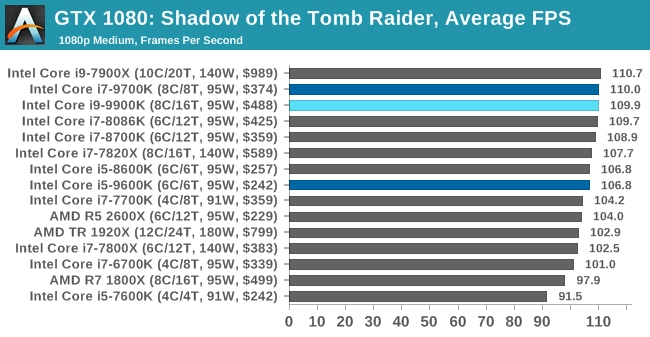 |
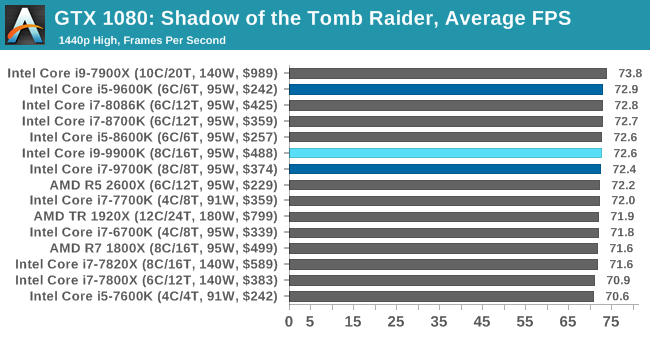 |
 |
| 95th Percentile | 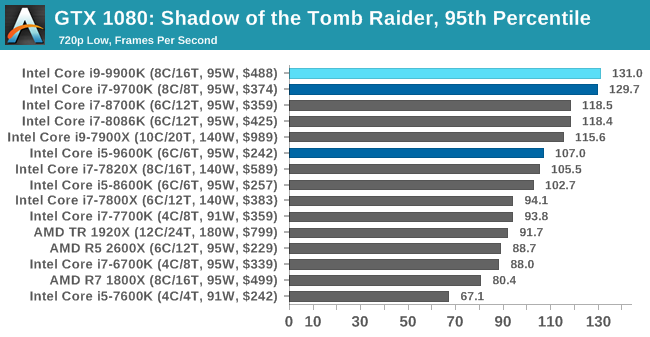 |
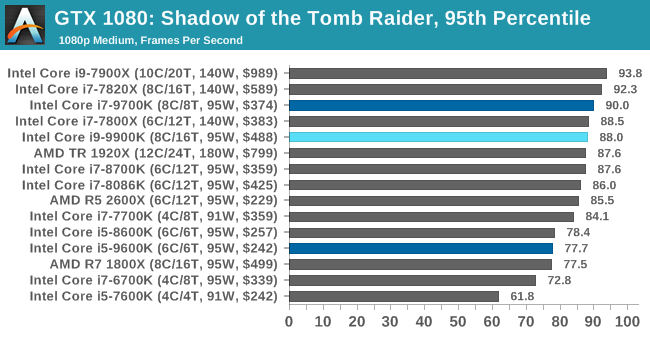 |
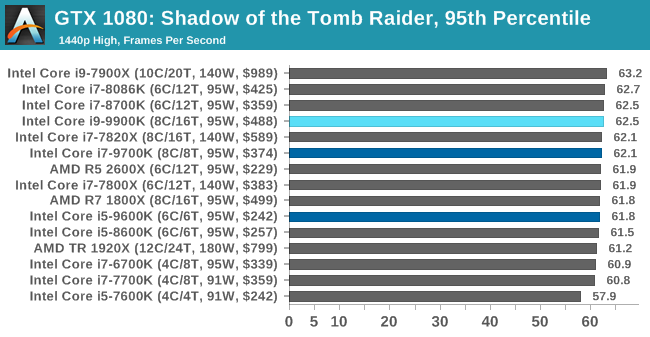 |
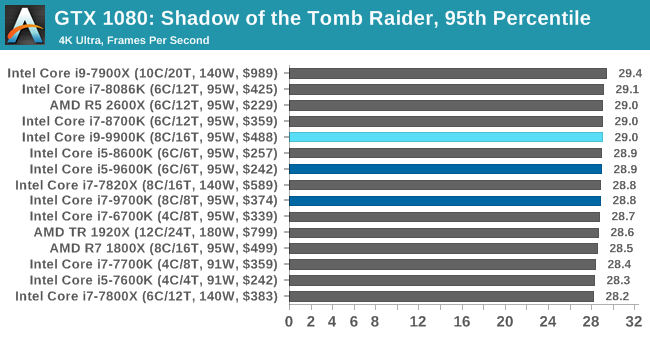 |
Diving into Shadow of the Tomb Raider, we have another game that’s mostly GPU-bound at its 1080p settings. At 1080p Medium the 9900K is actually a step behind the 7900K – noisy results in their purest form – while at 720p Low it’s still technically behind the 9700K. Either way, once we turn down our settings low enough to remove the GPU bottleneck, its overall another typical showing for the new CFL-R processors. Intel’s latest and greatest is several percent ahead of its predecessors, but none of these games are in a position to really take advantage of the extra two cores. So instead it’s all about frequency and L3 caches.
Though this game (like so many others) does seem to reinforce the idea that the 9600K is the new 8700K. The 8700K is still ahead by a few frames at CPU-bound settings, but despite losing HT, the 9600K is still hanging in the fight for a noticeably lower price.


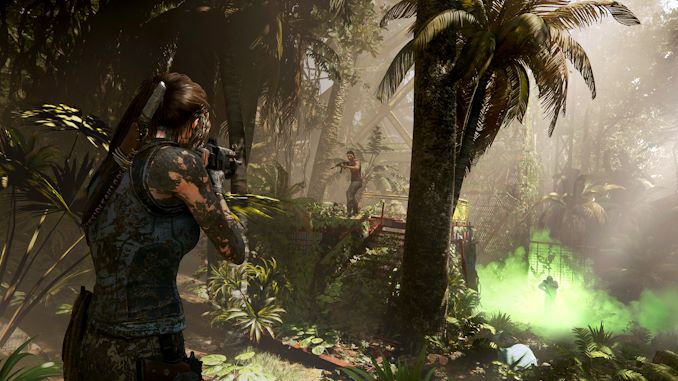









274 Comments
View All Comments
Targon - Friday, October 19, 2018 - link
TSMC will do the job for AMD, and in March/April, we should be seeing AMD release the 3700X and/or 3800X that will be hitting the same clock speeds as the 9900k, but with a better IPC.BurntMyBacon - Friday, October 19, 2018 - link
I am certainly happy that AMD regained competitiveness. I grabbed an R7 1700X early on for thread heavy tasks while retaining use of my i7-6700K in a gaming PC. That said, I can't credit them with everything good that comes out of Intel. To say that Intel would not have released an 8 core processor without AMD is probably inaccurate. They haven't released a new architecture since Skylake and they are still on a 14nm class process. They had to come up with some reason for customers to buy new processors rather than sit on older models. Clock speeds kinda worked for Kaby Lake, but they need more for Coffee Lake. Small, fixed function add-ons that only affect a small portion of the market probably weren't enough. A six core chip on the mainstream platform may have been inevitable. Going yet another round without a major architecture update or new process node, it is entirely possible that the 8-core processor on the mainstream platform was also inevitable. I give AMD credit for speeding up the release schedule, though.As to claims that the GF manufacturing is responsible for the entire 1GHz+ frequency deficit, that is only partially true. It is very likely that some inferior characteristics of the node are reducing the potential maximum frequency achievable. However, much of the limitations on frequency also depends on how AMD layed out the nodes. More capacitance on a node makes switching slower. More logic between flip-flops require more switches to resolve before the final result is presented to the flip-flops. There is a trade-off between the number of buffers you can put on a transmission line as reducing input to output capacitance ratios will speed up individual switch speeds, but they will also increase the number of switches that need to occur. Adding more flip-flops increases the depth of the pipeline (think pentium 4) and increases the penalty for branch misses as well as making clock distribution more complicated. These are just a few of the most basic design considerations that can affect maximum attainable frequency that AMD can control.
Consequently, there is no guarantee that AMD will be able to match Intel's clock speeds even on TSMC's 7nm process. Also, given that AMD's current IPC is more similar to Haswell and still behind Skylake, it is not certain that they next processors will have better IPC than Intel either. I very much hope one or the other ends up true, but unrealistic expectations won't help the situation. I'd rather be pleasantly surprised than disappointed. As such, I expect that AMD will remain competitive. I expect that they will close the gaming performance gap until Intel releases a new architecture. I expect that regardless of how AMD's 7nm processors stack against Intel's best performance-wise, I expect that AMD likely bring better value at least until Intel gets their 10nm node fully online.
Spunjji - Monday, October 22, 2018 - link
"To say that Intel would not have released an 8 core processor without AMD is probably inaccurate."It's technically inaccurate to say they would have never made any kind of 8-core processor, sure, but nobody's saying that. That's a straw man. What they are saying is that Intel showed no signs whatsoever of being willing to do it until Ryzen landed at their doorstep.
To be clear, the evidence is years of Intel making physically smaller and smaller quad-core chips for the mainstream market and pocketing the profit margins, followed by a sudden and hastily-rescheduled grab for the "HEDT" desktop market the second Ryzen came out, followed by a rapid succession of "new" CPU lines with ever-increasing core counts.
You're also wrong about AMD's IPC, which is very clearly ahead of Haswell. The evidence is here in this very article where you can see the difference in performance between AMD and Intel is mostly a function of the clock speeds they attain. Ryzen was already above Haswell for the 1000 series (more like Broadwell) and the 2000 series brought surprisingly significant steps.
khanikun - Tuesday, October 23, 2018 - link
" What they are saying is that Intel showed no signs whatsoever of being willing to do it until Ryzen landed at their doorstep."Intel released an 8 core what? 3 years before Ryzen. Sure, it was one of their super expensive Extreme procs, but they still did it. They were slowly ramping up cores for the HEDT market, while slowly bringing them to more normal consumer prices. 3 years before Ryzen, you could get a 6 core i7 for $400 or less. A year before that it was like $550-600. A 1-2 years before that, a 6 core would be $1000+. 8 cores were slowly coming.
What Ryzen did was speed up Intel's timeframe. They would have came and came at a price point that normal consumers would be purchasing them. If I had to guess, we're probably 2-3 years ahead of what Intel probably wanted to do.
Now would Ryzen exist, if not for Intel? Core for core, AMD has nothing that can compete with Intel. So...ramp up the core count. We really don't see Intel going away from a unified die design, so that's the best way AMD has to fight Intel. I'm personally surprised AMD didn't push their MCM design years ago. Maybe they didn't want to cannibalize Opteron sales, bad yields, I don't know. Must have been some reason.
Cooe - Friday, October 19, 2018 - link
Rofl, delusional poster is delusional. And anyone who bought a 2700X sure as shit doesn't need to do anything to "defend their purchase" to themselves hahaha.evernessince - Saturday, October 20, 2018 - link
Got on my level newb. The 9900K is a pittance compared to my Xeon 8176. I hope you realized that was sarcasm and how stupid it is to put people down for wanting value.JoeyJoJo123 - Friday, October 19, 2018 - link
>I think far too much emphasis has been placed on 'value'.Then buy the most expensive thing. There's no real need to read reviews at that point either. You just want the best, money is no object to you, and you don't care, cool. Just go down the line and put the most expensive part for each part of the PC build as you browse through Newegg/Amazon/whatever, and you'll have the best of the best.
For everyone else, where money is a fixed and limited resource, reading reviews MATTERS because we can't afford to buy into something that doesn't perform adequately for the cost investment.
So yes, Anandtech, keep making reviews to be value-oriented. The fools will be departed with their money either way, value-oriented review or not.
Arbie - Friday, October 19, 2018 - link
They'll be parted, yes - and we can hope for departed.GreenReaper - Saturday, October 20, 2018 - link
Don't be *too* harsh. They're paying the premium to cover lower-level chips which may be barely making back the cost of manufacturing, thus making them a good deal. (Of course, that also helps preserve the monopoly/duopoly by making it harder for others to break in...)Spunjji - Monday, October 22, 2018 - link
Yeah, to be honest the negatives of idiots buying overpriced "prestige" products tend to outweigh the "trickle down" positives for everyone else. See the product history of nVidia for the past 5 years for reference :/